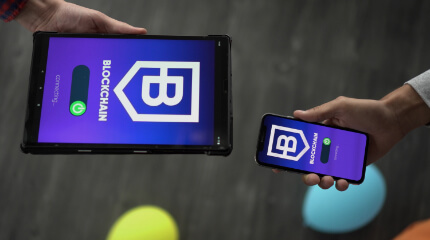How Much Does It Cost to Develop a Banking App Like Halifax in UK?
May 2025

The banking and finance sector has always been late in embracing new technologies. Whether banks and financial institutions like it or not, they must modernize their services because people’s expectations have increased. 70% of customers expect banks to provide personalized services. Some banks observe these trends and improve their services. For example, a recent study states that over 50% of the top 10 ranking European banks are from the UK.
Undoubtedly, many banks will want to emulate their success. They may even think that it requires significant infrastructure investments and the adoption of advanced technologies. The solution is to develop a mobile banking app like Halifax. This task may sound easy on paper, but it requires detailed planning, robust architecture, and implementation of stringent security measures.
What are the costs of developing an app like Halifax? Which features should we include? How do I know if my bank needs a mobile app? Anyone wanting to build a complex and powerful banking app will have thousands of thoughts running through their head. This blog is a detailed guide on the costs and other considerations for building a mobile banking app like Halifax. Let’s get started.
Why is the Halifax Banking App So Popular?
The global mobile banking market is projected to reach USD 4.26 billion by 2032. These statistics are proof that the banking app market has immense growth potential. One of the top UK banking apps is that of Halifax. In an ocean of banking apps, what makes Halifax’s app so special? Let’s dive into the details.
User-Friendly Interface
Halifax’s mobile banking app's biggest USP is its simplicity and accessibility. Whether Gen X, millennial, or Gen Z, the app makes managing finances easy for everyone.
Robust Security
Fingerprint and facial recognition, two-factor authentication, and real-time fraud alerts are just a few examples of security measures that enhance transaction safety for customers.
Extensive Features
The Halifax mobile app allows users to check their balances, transfer money, manage direct debits, apply for loans/credit cards, view statements, and more.
Stability
Users find Halifax’s app dependable and stable because it works well for the most part. Almost zero crashes or bugs.
Lloyd’s Group
Halifax is part of the Lloyd’s banking group, a trusted name in the banking and finance sector. Thanks to this, Halifax has access to advanced tech, vast financial resources, and a solid reputation.
Regular Updates
Every now and then, Halifax rolls out new features, updates, and bug fixes to enhance performance and usability. This ensures optimal app functioning to meet the ever-changing needs of users.
24/7 Customer Service
Customers can get fast assistance via in-app messaging, direct calls, chatbots, and more. No more waiting in long queues for problem resolution.
8 Factors Affecting the Cost to Develop a Banking App Like Halifax
The cost to develop an app like Halifax depends on many factors. Below are some app development costs to consider for banking and financial institutions.
1) Platform Choice
Which platform is the best for banking app development? Is it iOS, Android, or hybrid apps? This choice can significantly impact the app development cost.
iOS and Android (native apps)
- When it comes to app development, native apps usually have a heftier price tag than cross-platform development. This is mainly because native apps require separate codebases and dedicated teams for iOS and Android.
- For instance, developers typically turn to Swift or Objective-C to develop iOS apps. Android developers may prefer Kotlin or Java.
- Implementing each feature, design element, and bug fix twice requires considerable time and effort. So, native app development can cost between $50,000 to $5,00,000.
Cross-Platform App Development
With cross-platform app development, developers have to write code for a single codebase. The codebase is designed to work seamlessly on Android and iOS, which helps cut down on development time and costs. With that being said, there are a few downsides to consider when it comes to cross-platform development.
- Noticeable dip in performance compared to native apps, especially while executing complex animations or high-speed processing.
- Native apps allow developers to use built-in tools and components. This facilitates development that aligns with user expectations while ensuring a natural and intuitive feel. Cross-platform development.
- iOS users expect gestures like swipe-to-go-back, smooth animations, and specific user visual styles. In contrast, Android users are more accustomed to back button behavior, material design elements, and other navigation patterns.
- Cross-platform development may not have the tools and components to meet Android user needs.
- Navigating the implementation of advanced features and hardware integrations can be a formidable obstacle for developers, particularly in a cross-platform setting.
- Generally speaking, cross-platform banking app development tends to be a better fit for startups and medium-sized businesses aiming to connect with a wider audience while keeping costs to a minimum.
- The price tag for cross-platform banking app development can vary significantly, ranging from $50,000 to over $3,00,000.
If a company decides to hire app developers in UK, the costs can skyrocket. App development companies in India can be 60 to 80 percent cheaper. At the same time, Indian developers are known to deliver top-notch output.
2) Features and Functionalities
Depending on the complexity of the banking app, the development costs can vary. Mobile banking apps like Halifax have advanced features such as the following-
Real-Time Account Management
- This feature enables customers to check their balances, access account history, and manage direct debits.
- Estimated cost - Between $20,000 and $32,000.
Transfers and Payments
- Facilitates seamless domestic and international fund transfers.
- Estimated Cost - Between $25,000 and $38,000.
Budgeting Tools
- Provides customers with comprehensive insights into spending habits, making financial management a breeze.
- Estimated Cost - Between $19,000 and $31,000.
Credit Score Monitoring
- Allows users to access their credit scores at no extra cost.
- In-app credit score checking is considered a soft inquiry. Hence, it doesn’t impact credit files.
- Estimated Cost - Between $12,000 and $20,000.
Card Management Features
- Customers can freeze/unfreeze, report lost cards, and reorder depending on their needs.
- Estimated Cost - Between $12,000 and $25,000.
The above figures are just to give our readers an approximate idea. Simple apps require less effort, while complex apps require significant time and effort.
- Simple Apps - Development time is between 3 to 6 months. Costs are generally between $25,000 to $50,000.
- Medium-Complexity Apps - Development time is between 6 to 8 months. Costs are generally between $50,000 to $70,000.
- Advanced/Complex Apps - Development time is between 9 to 12 months. Costs are generally between $70,000 to $2,00,000.
3) UI and UX
- Typically, UI and UX account for 15 to 20 percent of the total development costs.
- With a clean and simple interface, the Halifax mobile app’s navigation allows users to perform regular tasks without much difficulty.
- In addition, personalized dashboards deliver specific insights related to customer spending habits, budgets, savings, and more.
- Delivering a UI/UX experience similar to Halifax involves four stages, namely, wireframing, prototyping, user testing, and implementation support.
- Together, the cost of the UI and UX development can be anywhere between $30,000 and $60,000.
- Advanced features can cost extra. Below is a brief description of the advanced UI/UX features (found in Halifax’s mobile app).
|
Features |
Description |
Estimated cost (USD) |
|
AI-Enabled Spending Insights |
Provides customers with a detailed analysis of their spending patterns |
$5000 - $15,000 |
|
Interactive Microinteractions |
Enhanced user engagement through subtle animations and feedback |
$3,000 - $10,000 |
|
Customizable Themes |
Users can personalize the app’s appearance to match their preferences, such as opting for dark mode |
$2,000 - $8,000 |
|
Voice Command Integration |
Enables app navigation through voice controls |
$10,000 - $20,000 |
|
Advanced Accessibility Options |
Includes features such as screen readers |
$5,000 - $12,000 |
4) Technology Stack
Choosing the right technology stack for app development is key, but one must also keep an eye on the costs involved. The tech stack cost to create a mobile banking app like Halifax is as follows-
Front-End Development
- iOS - Swift or Objective-C
- Android - Kotlin or Java
- Cross-Platform - Flutter, React Native
- UI/UX Design - Figma, Adobe XD
- Approximate Costs - $30,000 - $100,000
Back-End Development
- Programming Languages - Node.js, Java, Python
- Frameworks - Express.js, Spring Boot, Django
- Database - PostgreSQL, MongoDB
- Authentication - OAuth 2.0, JWT
- API Integration - RESTful APIs, GraphQL
- Approximate Costs - $50,000 - $150,000
Advanced Tech Considerations
- Implementing the following features can add to development costs.
- Artificial Intelligence and Machine Learning - $20,000 - $100,000+
- Blockchain Integration - $50,000 - $200,000+
- Advanced Security Protocols - $10,000 - $50,000+
Combining AI and machine learning, Halifax’s mobile app delivers exclusive insights for users and prioritizes the safety of confidential data. Companies wanting to deliver a Halifax-like experience should consider these integrations. For those companies that don’t need these integrations (small or medium-sized companies) can choose to opt out. For more information, consult a reputed firm providing app development services in the UK.
5) Regulatory Compliance
For banking companies, ensuring they meet regulatory standards is non-negotiable. The costs associated with compliance can differ significantly, based on location and specific requirements, falling between 10% and 20%, or roughly $5,000 to $65,000. A mobile banking app like Halifax employs several strategies to maintain regulatory compliance.
- Biometric Authentication - This feature harnesses fingerprint and facial recognition technology to ensure fast and secure access for customers.
- Encryption Protocols - Ensures end-to-end encryption to protect customer data during transmission and storage.
- Fraud Detection - Monitors transactions in real-time to detect and prevent unauthorized transactions.
Regulatory Compliance - Ensures adequate compliance with financial regulations, including GDPR for data protection and FCA standards (in the UK) for financial operations.
Device Registration - Access to the app is limited to registered devices, which offers protection against unauthorized sign-in and use.
Below is a table that gives us an approximate idea of compliance-related costs.
|
Area of Compliance |
Estimated Costs (USD) |
|
PCI DSS |
$5,000 - $2,00,000+ |
|
GDPR |
$10,000 - $50,000+ |
|
FCA |
$15,000 - $100,000+ |
|
Open Banking (UK) |
$10,000 - $75,000+ |
|
Pen Testing & Other Tools |
$7,000 - $35,000+ |
The high costs apply to highly regulated financial sectors. To gain better clarity, it is wise to consult specialized financial lawyers and regulatory compliance consultants.
6) Third-Party Integrations
Halifax has not disclosed all the third-party integrations it uses. Just like Halifax, a lot of banks use third-party integrations, including the ones below.
- Open-Banking APIs - Enables users to safely share their financial data with authorized third-party service providers.
- Payment Gateways - Ensures seamless transactions by integrating smoothly with payment processing services.
- Credit Score Providers - Integrating the banking app with credit reporting agencies allows users to check their credit scores.
- Property Data Platforms - Possible integration with property data providers to provide users with information related to mortgage services.
- Biometric Authentication - Biometric authentication ensures safe and convenient access for users.
The table below with approximate costs is just to give you a brief idea. Consult a banking or fintech app development company in UK for more details.
|
Integration |
Percentage of Total Cost |
Approx Cost in USD |
|
Open Banking APIs |
8% - 10% |
$40,000 - $70,000 |
|
Payment Gateway |
5% - 7% |
$30,000 - $45,000 |
|
Credit Score Providers |
4% - 6% |
$25,000 - $35,000 |
|
Property Data Platforms |
3% - 5% |
$20,000 - $30,000 |
|
Biometric Authentication |
2% - 4% |
$12,000 - $25,000 |
|
Analytics |
2% - 3% |
$15,000 - $20,000 |
|
Fraud Detection/Security SDKs |
3% - 7% |
$30,000 - $40,000 |
7) Testing
Creating a banking app is just the beginning. Before it can officially launch, thorough testing is necessary to make sure it works smoothly, offers a considerable degree of security, and exceptional user experience. In case of advanced mobile apps similar to Halifax's, the app undergoes various testing stages. Each type of testing is for a specific purpose. The cost breakdown is as follows-
- Unit, Integration, UI, and End-to-End Testing - This will take up 20% of the total QA budget, costing between $30,000 to $50,000.
- Penetration Testing and Vulnerability Scanning - Requires 25% allocation of the total QA budget, with costs ranging from $40,000 to $70,000.
- Beta Testing - Needs 10% allocation of the QA budget, costing between $15,000 and $25,000.
- Manual and Automation Engineers - Accounts for 40% of the QA budget, costing between $70,000 and $100,000.
- Tools, Licenses, and Platforms - Requires 5% allocation of the total QA budget, costs between $5,000 to $10,000.
8) Maintenance and Updates
Designing the perfect banking app with innovative features is futile if it cannot stand the test of time. To make sure it runs without any issues, continuous maintenance and updates are key. For a banking app with sophisticated features and a mammoth user base like Halifax, one can expect the maintenance costs to be around 15% to 20% of the initial development costs per year.
Stage-Wise Breakdown of Costs to Develop a Banking App Like Halifax
Developing a mobile banking app like Halifax is a complex process that involves multiple stages. The costs for each stage are as follows-
1) Planning and Research
Suppose you want to create a banking app like Halifax. In that case, you need to ask yourself some key questions before diving in.
- Is your business similar to Halifax, or are you a mid-range company?
- What does your target audience expect from the app?
- Do the users require financial advice or seamless, secure transactions?
- What actions do users want to perform using the banking app?
- What problems does the app solve?
Meanwhile, organizations must perform thorough competitor research, identify the pain points of their target audience, and choose the features they want to include in the app. Plus, they will need to figure out whether to launch the app on iOS or Android. This phase can take anywhere from a week to five weeks and costs between $5,000 to $15,000.
2) UI/UX Design
Knowing what the final product will appear to the end user before kicking off development. By creating the app’s visual layout and UX, stakeholders can get a clear view of the structure, identify usability issues, and make adjustments as necessary. Designers make this possible by creating the following-
- Wireframes - Low-fidelity representation of the app’s layout, like the app blueprint.
- Mockups - High-fidelity static designs that add colors, visual elements, and logos to wireframes.
- Prototypes - Interactive and clickable versions of the app’s design.
- Expect this stage to last at least 15 days, if not longer, with costs fluctuating based on the number of screens. Generally, you are looking at an average cost that falls between $5,000 and $30,000.
3) App Development
Development is where the magic happens. It breathes life into the design. App development includes two parts: backend and front-end development.
- Front-end Development - Process of building the visual interface that users interact with.
- Back-end Development - Powers server-side logic, databases, and security behind the app.
Depending on the complexity of the project, its deadlines, and various other constraints, businesses can pick from choosing agile or waterfall methodologies. These are the two most common approaches to app development.
- Agile Methodology - Adopts a dynamic and flexible approach, focusing on delivering results in fixed-length iterations or sprints that can last from 1 to 4 weeks, all while incorporating ongoing feedback.
- Waterfall Methodology - In contrast, this method follows a linear/sequential path, meaning one must finish a development stage before jumping to the next.
The development stage is crucial, and costs can range from $30,000 to $300,000. Several factors influence these costs, such as the choice of platform, design elements, testing, integration, and more.
4) Testing
In the section above, we already covered the different types of testing for a banking app. The costs associated with testing can vary considerably, based on its complexity and the testing methods employed. To build a mobile banking app like Halifax, companies may be looking at a price that falls between $5,000 and $100,000.
5) Marketing and Deployment
Before the final product is made available to the end users, it is necessary to promote and advertise it effectively to drive downloads and collect feedback. Companies can use a range of channels, from social media, influencers, electronic media, and email campaigns. The cost depends on the marketing efforts. However, the marketing and deployment cost for a mobile banking app like Halifax can be anywhere from $200,000 to $500,000.
The above table is just to give readers a brief idea about the marketing and deployment costs. Consult a reputed mobile banking app development company for accurate estimates.
6) Maintenance and Updates
If we consider a mobile banking app like Halifax, the costs for maintenance and updates can vary significantly, landing somewhere between $200,000 to $6,90,000. Introducing new features, exceeding customer expectations, rolling out updates, and adding new features can be a tough nut to crack. The increased complexity and ongoing nature of this task make it expensive.
The table below is a small breakdown of the maintenance and update costs for a complex banking app.
|
Category |
Monthly Costs (USD) |
Annual Costs (USD) |
Key Objectives |
|
Routine Maintenance |
$2,000 - $2,500 |
$24,000 - $30,000 |
Bug fixes, performance tuning, and minor updates |
|
Platform Updates |
$3,000 - $10,000 |
$36,000 - $120,000 |
OS compatibility and device updates |
|
UI/UX Enhancements |
$2,000 - $10,000 |
$24,000 - $120,000 |
Design and usability improvements |
|
Security and Compliance |
$5,000 - $20,000 |
$60,000 - $240,000 |
Regulatory updates and security audits |
|
Third-Party Integrations |
$1,000 - $5,000 |
$12,000 - $60,000 |
Hosting servers and scalability |
|
Support |
$2,000 - $5,000 |
$24,000 - $60,000 |
24/7 support and app monitoring |
|
Feature Updates |
N/A |
$24,000 - $50,000 per update |
Vital features based on market changes and user needs |
9 Top Features to Include Similar to a Mobile Banking App Like Halifax
We need to understand why Halifax’s mobile banking app is so successful. The reason is simple. They understand user needs, use the latest technology, and keep the design simple to improve usability. When the banking app fulfils all customers' needs, they have nothing to complain about. Below are some of the Halifax mobile banking app’s salient features.
1) Simplified Daily Banking
- Unified Account View - Allows customers to access accounts, cards, and savings in a single location.
- Smart Budgeting - Track spending by category, set budgets, and receive timely bill reminders.
- Rewards - Avail cashback and bespoke deals.
2) Home and Mortgage Management
- Mortgage Tracker - Monitors balance, payments, and equity.
- Property Insights - Provides home value estimates and highlights market trends.
- Green Tips - Valuable tips related to eco-friendly practices and offers.
3) Borrowing and Credit Tools
- Full Credit Overview - Complete info on loans, overdrafts, and cards.
- Live Credit Score - Allows customers to track and improve their credit score, accompanied by tips.
- Custom Loan Offers - Explore pre-approved loan options and calculators.
4) Savings and Investments
- Instant Transfers - Transfer funds easily between accounts.
- Savings and Investments View - Track linked accounts and investments.
- Goal-Based Savings - Set goals and automate round-ups.
5) Insurance Hub
- Comprehensive Access - Manage car, home, travel, and life insurance under one roof.
- Renewal Reminders - Get alerts and personalized coverage suggestions.
6) Bulletproof Security
- Biometric Login - Includes Face ID, fingerprint, and 2-factor authentication support.
- Card Controls - Freeze, unfreeze, or set limits instantly.
- Fraud Alerts - Stay protected 24/7 with real-time notifications.
7) Personalized Experience
- Custom Dashboards - Rearrange widgets and themes.
- Flexible Alerts - Choose from push, text, and email updates.
- Accessibility - Voice commands, screen readers, and multilingual options.
8) Seamless Payments and Transfers
- Quick Bill Pay - Schedule or transfer funds in seconds.
- Tap & QR Pay - Use contactless and QR payments.
- Subscription Management - View, edit, or cancel recurring charges.
9) Organized Document Storage
- E-Statements - Download and sort by category.
- Tax Reports - Facilitates quick and easy generation of expense summaries.
- Secure Vault - Store important documents safely.
Confused about which features to include in your mobile banking app? Consult a leading app development company in the UK for detailed guidance.
Additional Suggestions - Feature Inclusions/Exclusions for a Mobile Banking App Like Halifax
Halifax includes several innovative features for customers. Copying their pattern or features may not be the solution for a banking company. Instead, banking companies must focus on building an app that meets the needs of their target audience while embracing current trends.
Below are additional suggestions to consider while creating a mobile banking app like Halifax.
Features to Include
- Virtual Financial Assistant - AI-powered chatbots designed to handle customer queries and guide customers 24/7.
- Family/Shared Accounts - Tools to manage joint/child accounts with parental controls.
- Offline Mode - View balances and recent transactions without internet access.
- Cardless ATM Access - Swift cash withdrawals using QR code or an app-generated code.
- Foreign Currency Management - Real-time FX rates, currency exchange, and multi-currency wallets.
- In-App Customer Support - Live chat or voice support integration within the banking app.
Features to Exclude
- Overly Complex Tools - Avoid features similar to advanced trading platforms unless the target audience is experienced/tech-savvy investors.
- Unnecessary Gamification - Badges or over-gamification can make customers lose trust in the banking app.
- Third-Party Ads - Ads can disrupt user experience and may raise privacy concerns.
- Non-Banking Features - Unnecessary, non-banking features such as news feeds can clutter the user interface and distract users from core features.
6 Challenges & Solutions - Creating a Mobile Banking App Like Halifax
Developing a mobile banking app like Halifax requires time, money, and considerable effort. While budget can be a constraint for companies, there are other challenges they may face. Below is a brief description of the challenges banking companies may face while developing complex, mobile banking apps.
Legacy System Integration
- Challenge - Many banking apps like Halifax operate on legacy banking infrastructure.
- Solution - Use middleware APIs and service buses to act as a bridge between obsolete banking systems and new mobile apps. This ensures smooth functioning with major adjustments.
Regulatory Compliance (UK-Specific)
- Challenge - Ensure compliance with FCA, PSD2, and open banking regulations without sacrificing UX.
- Solution - Implement a modular compliance framework with real-time monitoring and dynamic policy updates.
Advanced Security
- Challenge - Balancing biometric/multi-factor authentication with usability.
- Solution - Leverage behavioral biometrics and silent fraud detection powered by AI to reduce interruptions.
Scalability Under Load
- Challenge - Managing peak traffic during payroll or outages can burden systems.
- Solution - Containerized microservices with auto-scaling on cloud platforms can be an effective solution.
Real-Time Transaction Processing
- Challenge - Deliver instant updates without draining battery or overloading APIs.
- Solution - Use server-sent events or MQTT protocols with throttled background syncs.
Privacy-Focused Personalization
- Challenge - Providing personalized insights without violating privacy regulations may result in loss of customer trust, and safeguarding user data.
- Solution - On-device machine learning for effective personalization while ensuring that sensitive data stays local.
Facing similar setbacks during mobile banking app development? Consider app development services in the UK that combine innovation with functionality.
Parting Thoughts
Building a custom banking app like Halifax is costly. That said, companies that have a vision for building Halifax-like mobile apps prioritize customer satisfaction over cost. Nevertheless, it does not mean costs are inconsequential, but small and medium-sized companies should not blindly copy Halifax’s app development pattern.
Complex features like AI-powered insights, card controls, and credit score monitoring are for elite companies like Halifax. Furthermore, such features can bump up development costs significantly. Suppose a company is looking to create a basic banking app with only the principal features, it can expect to spend between $80,000 to $150,000 (which is roughly £64,000 to £120,000). But, if they want to add complex features like the ones we talked about earlier, the price could jump by 200%, bringing the total to $300,000 to $600,000 (or £240,000 to £480,000).
Custom mobile banking app development is not just about coding. It requires a thoughtful and detailed approach. Along with focusing on a user-friendly UX/UI, banking firms must choose the right tech stack and integrations. It's also crucial to have a solid grasp of local regulations and understand what customers want. That’s why it is important to partner with a dedicated app development company in the UK that caters to a company’s specific needs.
At Hyperlink InfoSystem, we pride ourselves on being a premier IT services provider that can help you craft a tailored mobile banking app like Halifax. Over the past decade, we have launched over 3000 apps for our clients across diverse sectors such as gaming, fintech, banking, travel, and retail. Our hard work, perseverance, and dedication have helped us earn the trust of 5000+ clients. Combining our extensive technical skills with solid banking insights allows us to design the perfect solution to fit your specific needs.
From brainstorming, design, development, to launch, Hyperlink InfoSystem will be your partner from start to finish. Are you on the hunt for reliable and result-driven app development services in the UK? Connect with one of our experts to see what we can do for you.
Schedule a Consultation Today
Frequently Asked Questions
It all depends on your budget and goals. Promote your app on social media channels (where your target audience is), partner with financial institutions, and capitalize on email marketing. Entice users with discounts, special offers, and referral bonuses.
Below are some useful tips that companies can follow while developing a mobile banking app like Halifax. They are as follows-
- Prioritize core features and add premium/advanced ones later.
- Build an MVP product. Add more features after testing the app in the market.
- Hire dedicated app developers in the UK or entrust the responsibility to offshore teams. The latter can help you cut costs without sacrificing quality.
- Adopt an agile development approach. Test in phases and don’t get carried away by adding too many features.
- Rather than investing in expensive hardware infrastructure, opt for a scalable cost infrastructure.
- Focus on security-based features at the start to avoid corrections/changes later.
Integrating AI in banking apps has significant advantages. This integration can help banks and end-users. The benefits are as follows-
- Tailored financial advice, personalized product recommendations, and timely alerts that align with user needs.
- Enjoy enhanced security with biometric authentication, smart anomaly detection, and solid fraud prevention algorithms. This can reduce fraud and enhance app security.
- AI-powered chatbots are on duty 24/7, ready to tackle customer questions and offer timely guidance, which elevates customer service.
- Empowered with valuable insights, budgeting tools, and tailored recommendations, customers can make informed decisions, resulting in enhanced financial management.
- Voice-powered and AI-powered payments make customers' lives easier.
- AI’s forecasting capabilities help customers plan their finances. Banks can leverage predictive analytics to design products that possess the right features to delight customers.
Banks and financial institutions aiming to provide smooth, secure, and accessible banking services should seriously consider building a mobile banking app like Halifax. Such an app can be a blessing for a variety of businesses, including banks, credit unions, fintech companies, and emerging companies looking to expand/grow quickly.
Yes, the location and target market can influence the cost and overall app development approach. If a company is considering hiring app developers in the UK, they must expect to shell out between 22 and 24 pounds an hour. In comparison, hiring app developers in India costs around $20 to $50 per hour. Also, development practices, legal requirements, and compliance laws can differ from country to country. In many cases, laws can also differ between regions within the same country.
Latest Blogs

Is BlockChain Technology Worth The H ...
Unfolds The Revolutionary & Versatility Of Blockchain Technology ...


IoT Technology - A Future In Making ...
Everything You Need To Know About IoT Technology ...

Feel Free to Contact Us!
We would be happy to hear from you, please fill in the form below or mail us your requirements on info@hyperlinkinfosystem.com
Hyperlink InfoSystem Bring Transformation For Global Businesses
Starting from listening to your business problems to delivering accurate solutions; we make sure to follow industry-specific standards and combine them with our technical knowledge, development expertise, and extensive research.
4500+
Apps Developed
1200+
Developers
2200+
Websites Designed
140+
Games Developed
120+
AI & IoT Solutions
2700+
Happy Clients
120+
Salesforce Solutions

40+
Data Science

















